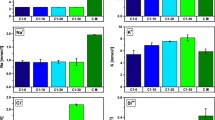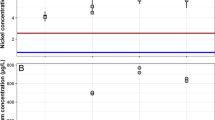Abstract
Leaching of polyurethane systems for waterproofing purposes of buildings was investigated in this study. As the curing step is the crucial point for potential impacts on the environment, leaching during this period was assessed by applying three different catalysts, in different amounts as well as two eluents. A modified and intensified version of the European horizontal dynamic surface leaching test was used. Complex assessment of all observed parameters was performed by using chemical as well as ecotoxicological tests. Inorganic and organic parameters were detected in a multi-method approach. The study was supplemented by an aquatic ecotoxicological assay on freshwater algae Desmodesmus subspicatus and a terrestrial assay with Enchytraeus albidus. While sum parameters like pH stayed constant over the test period, up to a maximum of 0.004 mmol/l Zn could be leached from one of the systems used in the intensified tank leaching test. Leaching of organic compounds reached a maximum (612 mmol/l) during the first leaching steps and decreased rapidly to a minimum. Ecotoxicological tests confirm the first leaching steps to be crucial as well as the dosage of the catalyst. Soil tests with E. albidus showed a realistic impact of the eluates on the environment.








Similar content being viewed by others
References
Chattopadhyay, D. K., & Raju, K. V. S. N. (2007). Structural engineering of polyurethane coatings for high performance applications. Progress in Polymer Science, 32, 352–418. doi:10.1016/j.progpolymsci.2006.05.003.
Cuellar-Bermudez, S. P., Aleman-Nava, G. S., Chandra, R., et al. (2016). Nutrients utilization and contaminants removal. A review of two approaches of algae and cyanobacteria in wastewater. Algal Research. doi:10.1016/j.algal.2016.08.018.
DAfStb-Richtlinie (2005) DAfStb-Richtlinie - Bestimmung der Freisetzung anorganischer Stoffe durch Auslaugung aus zementgebundenen Baustoffen.
DIBt. (2009a). Grundsätze zur Bewertung der Auswirkungen von Bauprodukten auf Boden und Grundwasser. DIBt Mitteilungen, 40, 116–134. doi:10.1002/dibt.200930029.
DIBt. (2009b). Grundsätze zur Bewertung der Auswirkungen von Bauprodukten auf Boden und Grundwasser. DIBt Mitteilungen, 40, 169–179. doi:10.1002/dibt.200930040.
DIBt. (2011). Deutsches Institut für Bautechnik: Grundsätze zur Bewertung der Auswirkungen von Bauprodukten auf Boden und Grundwasser. DIBt Mitteilungen, 42, 196–212. doi:10.1002/dibt.201130042.
Didden, W., & Römbke, J. (2001). Enchytraeids as indicator organisms for chemical stress in terrestrial ecosystems. Ecotoxicology and Environmental Safety, 50, 25–43. doi:10.1006/eesa.2001.2075.
DIN 19631 (2016) Elution von Baustoffen - Perkolationsverfahren zur Untersuchung des Elutionsverhaltens von Bodeninjektionsmitteln.
DIN 38412-33 (1991) Deutsche Einheitsverfahren zur Wasser-, Abwasser- und Schlammuntersuchung - Testverfahren mit Wasserorganismen (Gruppe L) - Bestimmung der nicht giftigen Wirkung von Abwasser gegegenüber Grünalgen (Scenedesmus-Chlorophyll-Fluoreszenztest) ü.
DIN CEN/TS 16637-2 (2014) Construction products—assessment of release of dangerous substances—part 2: horizontal dynamic surface leaching test.
DIN EN ISO 16387 (2014) Bodenbeschaffenheit – Wirkungen von Verunreinigungen auf Enchytraeidae (Enchytraeus sp.) – Bestimmung der Wirkungen auf die Reproduktion.
DIN EN ISO 8692 (2012) Wasserbeschaffenheit - Süßwasseralgen-Wachstumshemmtest mit einzelligen Grünalgen.
European Commission (2016) REACH - Chemicals - Environment - European Commission. In: Eur. Comm. website. http://ec.europa.eu/environment/chemicals/reach/reach_en.htm.
Huber, S. A., Balz, A., Abert, M., & Pronk, W. (2011). Characterisation of aquatic humic and non-humic matter with size-exclusion chromatography-organic carbon detection-organic nitrogen detection (LC-OCD-OND). Water Research, 45, 879–885. doi:10.1016/j.watres.2010.09.023.
Ilvonen, O. (2013). Assessing release of hazardous substances from construction products—review of 10 year experience with horizontal approach in the European Union. Building and Environment, 69, 194–205. doi:10.1016/j.buildenv.2013.08.010.
Krol, P. (2007). Synthesis methods, chemical structures and phase structures of linear polyurethanes. Properties and applications of linear polyurethanes in polyurethane elastomers, copolymers and ionomers. Progress in Materials Science, 52, 915–1015. doi:10.1016/j.pmatsci.2006.11.001.
LAWA (2004) Ableitung von Geringfügigkeitsschwellen für das Grundwasser.
Lock, K., & Janssen, C. R. (2001). Modeling zinc toxicity for terrestrial invertebrates. Environmental Toxicology and Chemistry, 20, 1901–1908. doi:10.1002/etc.5620200907.
Märkl, V., Pflugmacher, S., & Stephan, D. A. (2017). Leaching of PCE-based superplasticiser from microfine cement: a chemical and ecotoxicological point of view. Water, Air, & Soil Pollution, 228, 217. doi:10.1007/s11270-017-3373-x.
Märkl, V., & Stephan, D. A. (2016). Release behaviour of major elements and superplasticiser from cement suspensions. Water, Air, & Soil Pollution, 227, 30. doi:10.1007/s11270-015-2730-x.
OECD (2011) Test no. 201: freshwater alga and cyanobacteria, growth inhibition test.
Oertel G, Abele L (1983) Polyurethane, Neuausg.,. Hanser, München.
Roembke, J., & Knacker, T. (1989). Aquatic toxicity test for enchytraeids. Hydrobiologia, 180, 235–242. doi:10.1007/BF00027556.
Römbke, J., & Moser, T. (2002). Validating the enchytraeid reproduction test: organisation and results of an international ringtest. Chemosphere, 46, 1117–1140. doi:10.1016/S0045-6535(01)00113-8.
Scott-Fordsmand, J. J., Maraldo, K., & van den Brink, P. J. (2008). The toxicity of copper contaminated soil using a gnotobiotic soil multi-species test system (SMS). Environment International, 34, 524–530. doi:10.1016/j.envint.2007.11.008.
WHO (2011) Guidelines for drinking-water quality, fourth edition. World Health Organization.
Acknowledgements
This study was financially supported by the Federal Ministry for Economic Affairs and Energy, Germany. The authors wish to acknowledge Anja Städtke, Mahboobeh Behmaneshfard and Jimmy Köpke (TU Berlin) for technical support, as well as Anke Putschew for the LC-OCD measurements.
Author information
Authors and Affiliations
Corresponding author
Rights and permissions
About this article
Cite this article
Märkl, V., Pflugmacher, S., Reichert, A. et al. Leaching of Polyurethane Systems for Waterproofing Purposes Whilest Curing. Water Air Soil Pollut 228, 280 (2017). https://doi.org/10.1007/s11270-017-3451-0
Received:
Accepted:
Published:
DOI: https://doi.org/10.1007/s11270-017-3451-0




